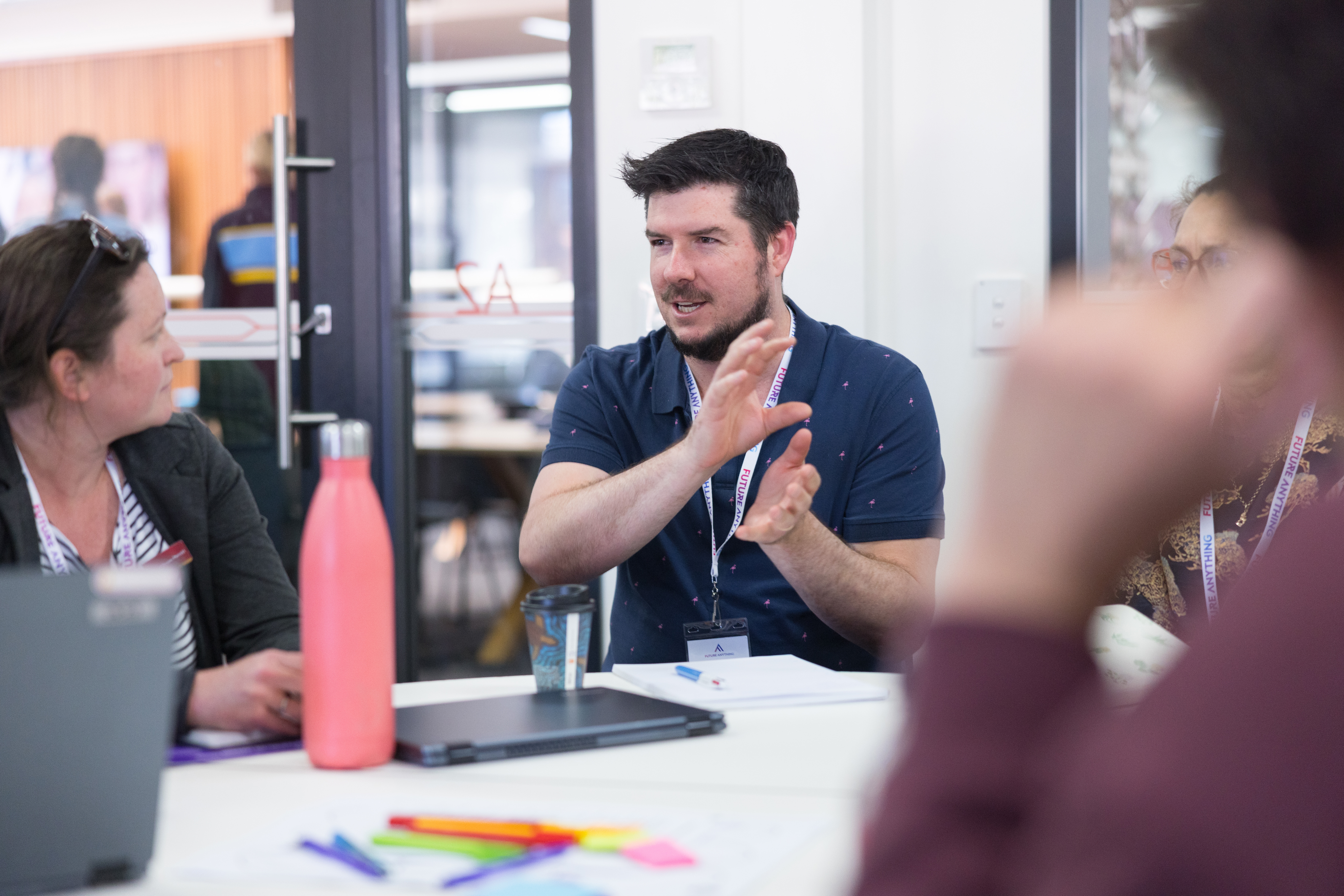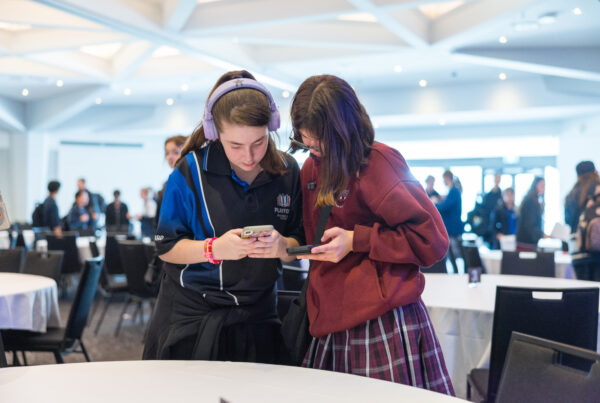
Co-Designing Learning: Inviting Students to the Planning Table
by Dan Dempsey, Director (Professional Learning), Future Anything
In today’s blog, Dan explores how co-designing learning with students can transform engagement, deepen authenticity, and make every voice count.
“One of the emerging findings is that the co-design of learning by teachers and students that builds on student needs and interests and links to authentic learning significantly impacts engagement.” Fullan, Quinn & McEachen, Deep Learning: Engage the World, Change the World (2018)
When was the last time you asked students for feedback on a unit…before it even began? Asking at the end is a bit like repainting a room, living in it for a term, and then saying, “So…do you like the colour?”
But in most schools, this is when the student feedback mostly happens – at the end of a unit: a survey, a reflection sheet, or a quick “what worked, what didn’t.”

By then, it’s too late to shape the learning. Students reflect, teachers nod, and the next unit is already moving on.
Co-design flips this approach. Bringing students into the planning process before the unit begins ensures their voice shapes content, assessments, and experiences from the start.
Why does student voice matter?
Research consistently shows that when students have genuine influence over their learning, motivation and engagement rise.
- John Hattie’s Visible Learning (2009) found that feedback (0.70 effect size) and student self-assessment (0.75) are among the most powerful influences on achievement.
- Michael Fullan, Joanne Quinn, and Joanne McEachen (2018) argue that engagement deepens when students “see themselves in the learning” and when it connects to authentic, real-world challenges.
- Jean Rudduck and Michael Fielding (2006) remind us that “consulting pupils is not enough.” Genuine student voice reshapes teaching and learning in partnership, not just in response.
- Dana Mitra (2008) shows how co-design builds belonging and agency, noting that students who help shape decisions develop a stronger sense of connection and purpose in school.
- And it’s not just research – policy echoes it too. Both the AITSL Standards and the Australian Student Wellbeing Framework (2018) emphasise that students should be active participants in shaping their learning and contributing to school decisions.
In short, student voice isn’t decoration. It’s the foundation.
So, how can you bring co-design to life and move student voice from theory into practice?At Future Anything, we leverage student co-design as a signature approach within our Four Day Engaging Curriculum Program. Throughout the course of the first two days, teachers move through a structured approach to curriculum and learning design, building a unit to around 70-80%. As part of Day 3, we invite students to join the workshop to engage in 7-10 min feedback rounds, a structured, carousel-style process where teachers present their 70-80% draft (work in progress) unit to small groups of students.

This particular part of the workshop is always incredibly well received by both teachers and students, enhancing the excitement, impact and momentum for the rest of the design and implementation. Comments from teachers include:
- “We had an incredibly authentic opportunity to ask students about what they’d like to learn, and to design with them.”
- “Having the students come in and provide feedback on our units of work that had been planned is transformational”
- “The feedback from students was my highlight. It affirmed that I had made some good judgments with the direction of the unit. And the questions they asked made me consider what tweaks I might need to make as I continued the writing process for the unit.”
How does it work?
Step 1: Before feedback rounds begin, it’s important to create the right context and some ‘rules of play’.
- Young people should outnumber teachers in each group. Students should be in control, which is important to help them feel safe, confident, and free to speak honestly.
- Teachers present and ask questions only – they don’t explain or defend decisions, but listen attentively and capture the feedback.
- Be respectful. Everyone’s ideas count — this is about exploration, not judgment.
- Capture everything. Every comment is valuable, even if it feels small.
Step 2: Creation of a ‘Feedback Bucket’ is the heart of the process — a single collection point for all student input.
Teachers are provided with an A3 image of a bucket and asked to record student comments using colour-coded sticky notes:
- 🟩 I Like — what excites or connects with students
- 🟨 I Wonder — what feels unclear or could be refined
- 🟥 I Wish — suggestions for improvement or new directions

Step 3: Four to six ‘feedback rounds’ (7-10 mins each) are conducted, with students rotating between teacher groups. The length of time for each round can be shortened as rounds progress.
Between rounds, teachers continue to rework their pitch, test their assumptions, highlight different aspects or try a different approach.

Step 4: Afterwards comes another key step: reflection. Teachers process the feedback using the lenses of:
- What is the echo? Feedback that resonates or points to an underlying challenge
- What are quick wins? Small shifts that can be made straight away
- What is a big win? Larger or more complex adjustments, but with greater transformative potential
Through reflection, teachers seek to understand the challenges, explore possible solutions, and then decide on deliberate actions to take forward. Some are quick wins, others are bigger shifts, but each is grounded in genuine student insight.
What to watch out for?
It is always good to remember that there can be a few traps to avoid when seeking feedback and input. Giving students too much background can sometimes blur or weaken their fresh perspective. Explaining or justifying decisions can shut down insights before they land and hamper student’s motivation. And perhaps the biggest risk: gathering feedback but shutting it down or never acting on it. Students will quickly disengage if they don’t see their input shaping change.
Co-design doesn’t mean taking on every idea. It means taking feedback seriously, then understanding, exploring, and deciding on the changes that matter most.
What are some other ways to implement, scale and sustain co-design?
Feedback rounds are one powerful entry point, but other strategies can include:
- Establish advisory panels where students contribute to decisions about curriculum, assessment, and culture.
- Inquiry projects can be re-shaped to give students choice over their questions, audiences, or showcase formats.
- Teachers might pilot assessment tasks with a small group before scaling, or run design-thinking workshops to uncover what matters most to learners.
- Sharing feedback outcomes at staff meetings can strengthen collective efficacy,
- Reporting can be reimagined through student-led conferences, where young people co-design and lead conversations about their own progress.
Each of these practices communicates the same message: your experience matters, and it belongs at the planning table.
Final Thought
At its heart, co-design is an invitation. It signals to students: you’re not just passengers – you’re part of the crew.
When schools embed co-design, engagement grows, relevance sharpens, and teachers plan with more clarity. As Mitra reminds us, student voice isn’t just about being heard – it’s about having influence.
Pair that with Hattie’s insights on feedback and Fullan’s call for deeper, more relevant learning, and the message is clear: when students co-design learning, everybody wins.
Want to dig deeper?
- Hattie, J. (2009). Visible Learning.
- Mitra, D. (2008). Student Voice in School Reform.
- Fullan, M. (2021). Deep Learning.
- AITSL (2017). Australian Professional Standard for Teachers – Standard 5.
- Australian Student Wellbeing Framework (2018). Emphasises student voice and agency.
About the author: Dan Dempsey
Dan Dempsey is a highly experienced educator, forging a successful 20-year career in education and school leadership in both Australia and the United Kingdom, notably through a range of Principal and Deputy Principal roles across varied primary school contexts
With a passion for building the capacity of schools, teams and systems to embed effective and innovative teaching, learning and assessment, Dan has developed significant experience providing professional learning, coaching and mentoring to teachers and leaders. Dan has a deep understanding of curriculum and pedagogy, with experience implementing and leading STEM initiatives, Project-Based Learning, inquiry and design thinking.
At Future Anything, Dan uses his extensive experience to provide targeted and bespoke support to empower schools, as well as facilitate the suite of teacher professional development programs, with the aim of providing educators the knowledge and skills to embed future-focussed learning experiences.
Future Anything’s Activate in-curriculum program and student workshops build confident communicators of all ages, by empowering young people to develop, and then persuasively pitch, innovative social enterprise solutions to the problems they care about.
Find out more about our programs here.






